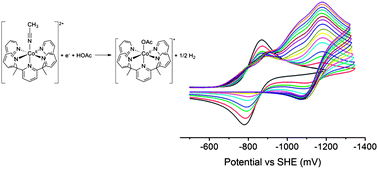A mechanistic study of protonreduction catalyzed by a pentapyridine cobalt complex: evidence for involvement of an anation-based pathway†
Abstract
The pentapyridine cobalt complex [Co(PY5Me2)]2+ and its congeners have been shown to catalyze

Maintenance work is planned for Wednesday 1st May 2024 from 9:00am to 11:00am (BST).
During this time, the performance of our website may be affected - searches may run slowly and some pages may be temporarily unavailable. If this happens, please try refreshing your web browser or try waiting two to three minutes before trying again.
We apologise for any inconvenience this might cause and thank you for your patience.
* Corresponding authors
a
Departments of Chemistry, University of California, Berkeley, California 94720, USA
E-mail:
chrischang@berkeley.edu, jrlong@berkeley.edu
b Departments of Molecular and Cell Biology, University of California, Berkeley, California 94720, USA
c Howard Hughes Medical Institute, University of California, Berkeley, California 94720, USA
d Materials Sciences Division, Lawrence Berkeley National Laboratory, Berkeley, California 94720, USA
e Chemical Sciences Division, Lawrence Berkeley National Laboratory, Berkeley, California 94720, USA
The pentapyridine cobalt complex [Co(PY5Me2)]2+ and its congeners have been shown to catalyze

 Please wait while we load your content...
Something went wrong. Try again?
Please wait while we load your content...
Something went wrong. Try again?
A. E. King, Y. Surendranath, N. A. Piro, J. P. Bigi, J. R. Long and C. J. Chang, Chem. Sci., 2013, 4, 1578 DOI: 10.1039/C3SC22239J
To request permission to reproduce material from this article, please go to the Copyright Clearance Center request page.
If you are an author contributing to an RSC publication, you do not need to request permission provided correct acknowledgement is given.
If you are the author of this article, you do not need to request permission to reproduce figures and diagrams provided correct acknowledgement is given. If you want to reproduce the whole article in a third-party publication (excluding your thesis/dissertation for which permission is not required) please go to the Copyright Clearance Center request page.
Read more about how to correctly acknowledge RSC content.
 Fetching data from CrossRef.
Fetching data from CrossRef.
This may take some time to load.
Loading related content
